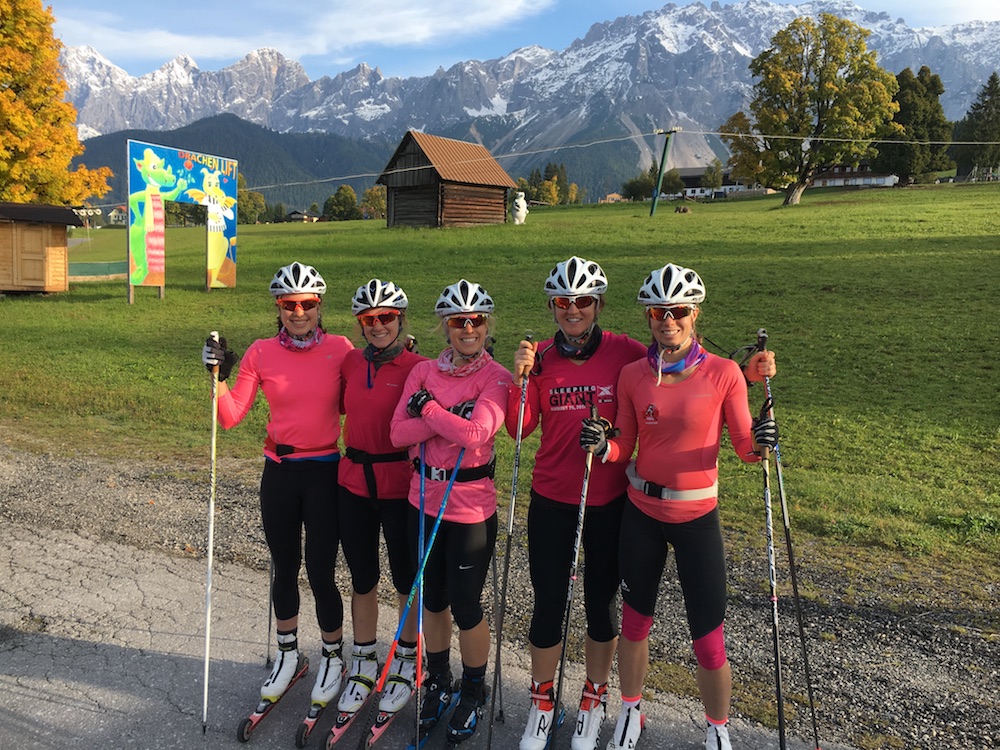
Coming off a big showing at 2017 World Cup Finals last March in Quebec City, the Thunder Bay National Team Development Centre (NTDC) — which sent six women and two men to the season-ending finals — is raring to go this winter.
The 14-member team is based out of Thunder Bay, Ontario, right in the middle of Canada. And while it might be a long ways from water (as Canada’s westernmost Atlantic port, some 3,700 kilometers from the mouth of the St. Lawrence seaway), Thunder Bay has a storied history in cross-country skiing, largely deriving from Finnish immigrants. The Lappe Nordic Ski Centre, which will host 2017 Canadian Ski Nationals, and Tapiola ski trails (referenced in the workout below) are at the heart of that history.
Fast-forward to the present, NTDC Thunder Bay as one of Canada’s big-three national-team training centres continues to gain momentum with some of the nation’s top skiers, many of which are women. Katherine Stewart-Jones, the overall NorAm leader at the end of last season, was renominated to the Canadian national U25 Team this spring, and Annika Richardson and Lisle Compton are members of the national Junior Team.
The following dryland workout was co-written by Stewart-Jones, Richardson, Compton, Alannah MacLean, Sadie White, and Mia Serratore, with contributions from Angus Foster and head coach Timo Puiras. So while the NTDC Thunder Bay team is currently fine-tuning for the season on snow at Lappe, here’s a running workout for those of us in less wintery climates.
***
“At NTDC Thunder Bay, we are proud to have one of the largest and strongest women’s training groups in Canada. With six girls on the training centre, ranging from Junior to U23 to Senior Women, there is a wide range of strengths and specializations within the group.

During the training season, the goal is to build base fitness and speed to create a good foundation for the ski season. One way to develop fitness is with Zone 3 intensity. Our go-to threshold workout is running intensity on a 750-meter loop at the Tapiola Ski Trails.
Instead of your typical track running workout, we run multiple loops of a relatively flat, hard-packed dirt trail at a prescribed lap pace. The aim is to stay as consistent as possible throughout the entire workout and to have the most even lap times upon completion of each set. Depending on prescribed lap times, this may be a workout with a partner or it may be solo, but it is an opportunity to focus on your own workout without trying to compete at your training partner’s pace.
The Workout: Zone 3 running intensity
Purpose: Target Zone3/threshold energy systems and improve efficiency
Warmup:
- Warmup: 15- to 30-minute run to wake the body up and get in the zone
- Dynamic joint prep: Some dynamic stretching to loosen up and prepare the body to move well! Think lunge with a side twist, ABC’s, karaoke, downward dog – all of these help to elongate muscles, warm up your body, and reduce the possibility of injury
- Activation sprints: A set of sprints to really get things moving and create a bit of lactate in the body. Aim for roughly 5 x 8 seconds with about 2 minutes of rest between each sprint, with a focus on being snappy and aggressive so that you go into a workout with a bit of fatigue and lactate in your muscles that you have to work through.
Determine max lap:
Prescribed pace or prescribed lap time is determined from the data acquired from the incremental-workload, running-treadmill test performed during the team’s testing camp in late May. The resulting calculated pace is the time that we must try and maintain for each lap throughout the workout. This pace is anaerobic threshold, or a pace that is “comfortably hard”. The prescribed pace is individualized for each athlete to ensure that the workout is completed according to that athlete’s running speed.
Periodically throughout the summer the team will run a “max lap” to recalibrate the prescribed pace. The max lap is one all-out effort of the 750 m loop.
Workout:
- 3 x 5 laps at your prescribed pace (depending on the athlete this can range somewhere between 2.5 to 3.5 minutes per lap) – pace should be comfortably hard for each athlete
Prescribed pace:
Maintaining a consistent pace for each lap will help to increase anaerobic threshold, the point at which your body gets tired at a steady state. Some athletes establish markers on the loop to get an idea of pacing (i.e. I have to pass this tree at 1:28 to run a 3:15 loop). We lap our watch for every loop in the set to monitor average heart rate per lap, and to see if that average increases, decreases or stays consistent throughout the duration of the workout. If you look like you are working too hard or your average heart rate increases drastically, the coaches will take a lactate. If it’s too high, you’re in trouble! Actually, [our coaches] Timo or Camille [Cheskey] will either read just your lap pace for the next set or you’ll be told to run alone because you were getting too competitive with your teammates.
Recovery: One easy lap and a quick drink break (approximately 5 minutes between sets)
Cool Down: Slow jog for 20-30 minutes with a couple surges into Zone 2 help to flush out all the lactic acid that built up in your legs throughout the workout. Some athletes will sit in the creek that runs beside the Tapiola trails as a form of cold tubbing.
The data from lap times and average heart rate is entered into a Google Drive document after each Tapiola workout. This serves as a tool to see lap time +/- the prescribed pace and heart rate across all laps and sets. All this data helps monitor how you are improving with each workout. If you’re capable of maintaining a consistent heart rate, then the pace will speed up for the next Tapiola intensity!

The goal of Tapiola is CONSISTENCY. Mental preparation and focus are the two keys for success. The pace is individually tailored to personal running speed to ensure that every athlete completes the workout at a speed that is best for them. However, this isn’t a workout where you can wing it. When you start to get tired by the last set, as you should be, maintaining good running technique and pacing requires conscious effort. Also, the athlete that runs the most consistent laps gets 10 points and a parrot sticker from Timo (a Finnish tradition).
Tapiola workouts start in June and we’ll run different variations of the workout described above about 6-10 times throughout the summer. It’s always surprising how much easier a Tapiola workout feels the second or third time you do it, even at a faster prescribed pace. It also has a big pay off in our running speed and fitness as we build into the training and racing seasons. This is one of our favourite workouts as part of NTDC Thunder Bay and why we wanted to share it with you!
Happy running!”

- anaerobic threshold
- Annika Richardson
- Canadian training centres
- dynamic stetching
- Katherine Stewart-Jones
- Lappe Nordic
- Lappe Nordic Centre
- Lappe Nordic Ski Centre
- Lappe Ski Centre
- Lisle Compton
- max effort
- NTDC Thunder Bay
- running intensity
- Tapiola Ski Trails
- threshold workout
- Thunder Bay
- Zone 3
- Zone 3 intensity
- Zone 3 running



